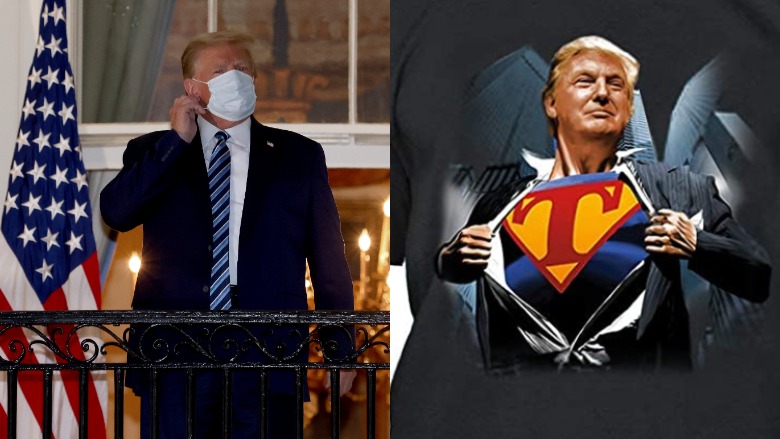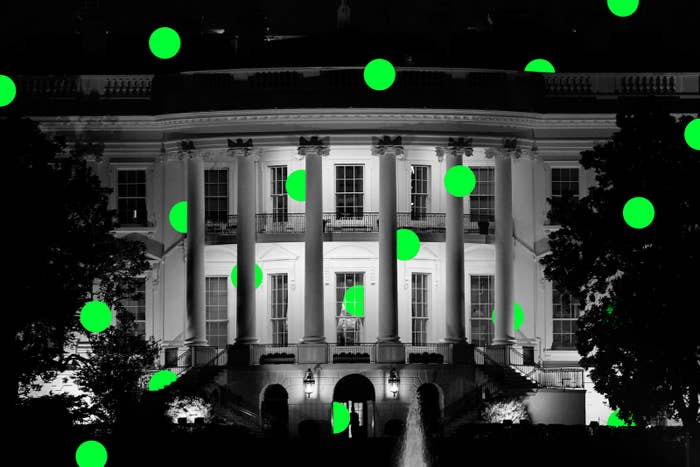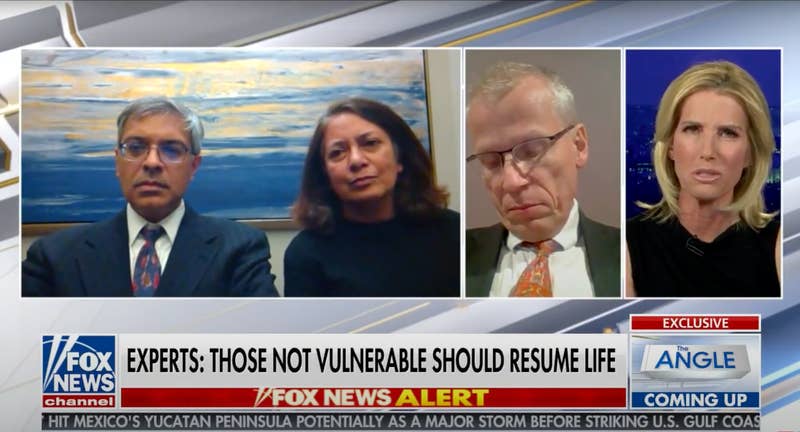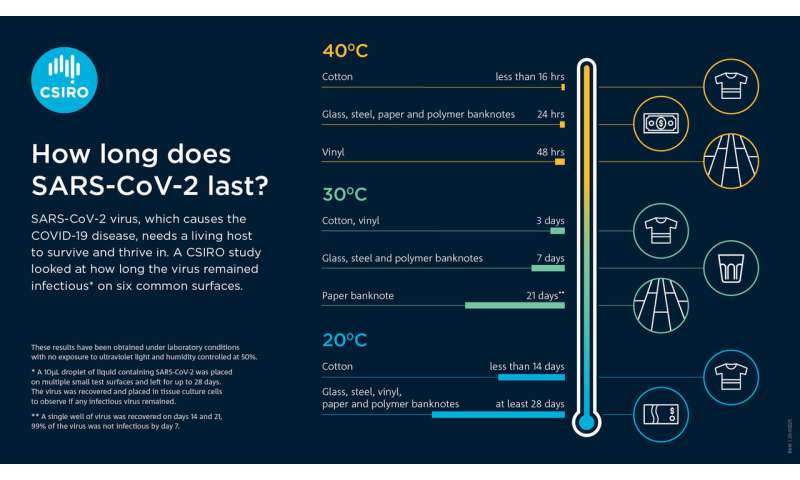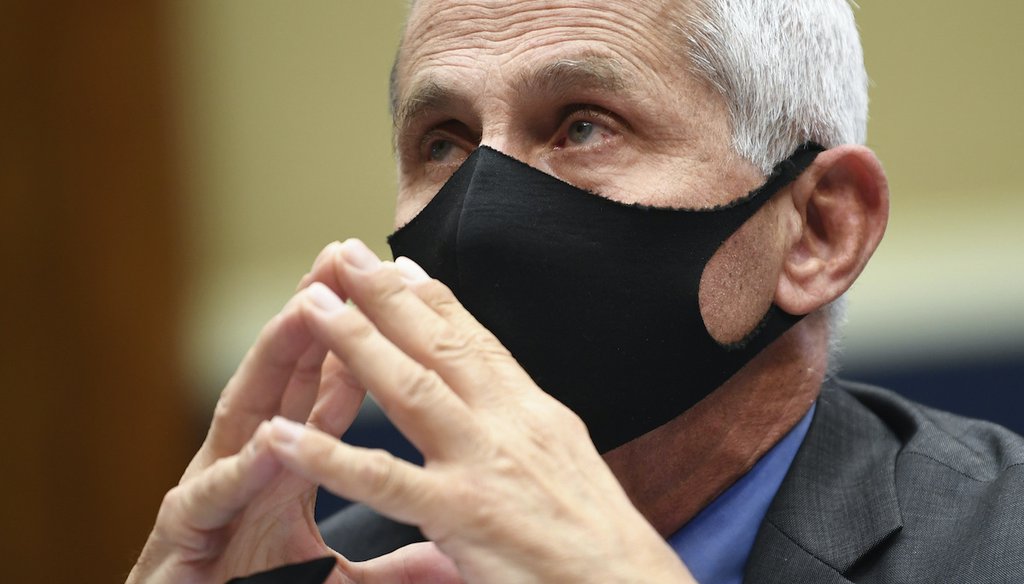CNN exclusive: Fauci says he was taken out of context in new Trump campaign ad touting coronavirus response
By Kaitlan Collins, CNN Sun October 11, 2020
(CNN) Dr. Anthony Fauci did not consent to being featured in a new advertisement from the Trump campaign touting President Donald Trump's handling of the coronavirus pandemic. Instead, the nation's leading infectious disease expert told CNN his words were taken out of context.
"In my nearly five decades of public service, I have never publicly endorsed any political candidate. The comments attributed to me without my permission in the GOP campaign ad were taken out of context from a broad statement I made months ago about the efforts of federal public health officials," Fauci said in a statement provided exclusively to CNN when asked if he agreed to be featured in the ad.
The Trump campaign released the new ad last week after the President was discharged from Walter Reed National Military Medical Center following treatment for Covid-19. The 30-second ad, which is airing in Michigan, touts Trump's personal experience with the virus and uses a quote from Fauci in an attempt to make it appear as if he is praising Trump's response.
"President Trump is recovering from the coronavirus, and so is America," the ad's narrator says. "Together we rose to meet the challenge, protecting our seniors, getting them life-saving drugs in record time, sparing no expense."
The ad then flashes to an interview with Fauci in which he says, "I can't imagine that anybody could be doing more."
Though no date is provided in the ad, Fauci's quote is from an interview with Fox News in March. During that interview, Fauci praised the White House coronavirus task force's round-the-clock effort to respond to the pandemic, which he says included numerous White House meetings and late-night phone calls.
"We've never had a threat like this. The coordinated response has been...There are a number of adjectives to describe it -- impressive, I think is one of them. We're talking about all hands on deck. I, as one of many people on a team, I'm not the only person," Fauci said at the time. "Since the beginning, that we even recognized what this was, I have been devoting almost full time on this. I'm down at the White House virtually every day with the task force. It's every single day. So, I can't imagine that under any circumstances that anybody could be doing more."
In response to Fauci saying the ad took his words out of context, Trump campaign communications director Tim Murtaugh said, "These are Dr. Fauci's own words. The video is from a nationally broadcast television interview in which Dr. Fauci was praising the work of the Trump Administration. The words spoken are accurate, and directly from Dr. Fauci's mouth."
The use of Fauci in the new ad appeared to be a recognition by the Trump campaign that the doctor is a voice voters trust when it comes to the pandemic. Trump has privately and publicly compared Fauci's approval with his own.
In late July, Trump publicly wondered why the doctor's approval rating is so high when his is so low.
"It's interesting: he's got a very good approval rating. And I like that, it's good," Trump said. "Because remember: he's working for this administration. He's working with us. We could have gotten other people. We could have gotten somebody else. It didn't have to be Dr. Fauci. He's working with our administration. And for the most part we've done what he and others -- and Dr. (Deborah) Birx and others -- have recommended."
Trump continued: "And he's got this high approval rating. So why don't I have a high approval rating with respect -- and the administration -- with respect to the virus? We should have it very high."
On ABC News Sunday, Jon Karl, who was guest hosting "This Week," said he requested Fauci for an interview, and although he was willing to come on, the White House blocked the appearance. Karl said other medical experts on the task force were also requested, but the White House did not offer anyone.
White House communications director Alyssa Farah noted on Twitter later Sunday that Fauci had made multiple appearances on television in the last week.
This story has been updated with comment from the Trump campaign

Fauci pushes back on use of comments in Trump campaign ad on coronavirus response
BY MELISSA QUINN OCTOBER 11, 2020 / 3:59 PM / CBS
Washington — Dr. Anthony Fauci, the nation's leading infectious disease expert, said Sunday his comments featured in an ad from the Trump campaign about the federal response to the coronavirus pandemic were taken out of context and used without his permission.
"In my nearly five decades of public service, I have never publicly endorsed any political candidate," Fauci, the director of the National Institute of Allergy and Infectious Diseases, said in a statement to CBS News. "The comments attributed to me without my permission in the GOP campaign ad were taken out of context from a broad statement I made months ago about the efforts of federal public health officials."
The 30-second ad from Mr. Trump's reelection campaign praises the president's handling of the coronavirus crisis and includes an edited clip of Fauci purportedly saying "I can't imagine that … anybody could be doing more," seemingly in reference to how Mr. Trump addressed the pandemic.
The clip, however, is from a March interview radio host Mark Levin conducted with Fauci for his show on Fox News, during which Fauci was asked whether he has witnessed "this big of a coordinated response by an administration" to such a public health threat.
Fauci described the federal response as "impressive" and said he and the other members of the White House coronavirus task force were working day and night to combat the spread of the coronavirus.
"There's a whole group of us that are doing that. It's every single day," he said.ail
Tim Murtaugh, the Trump campaign's communications director, defended the use of Fauci's comments in the ad in a statement.
"These are Dr. Fauci's own words," he said. "The video is from a nationally broadcast television interview in which Dr. Fauci was praising the work of the Trump administration. The words spoken are accurate, and directly from Dr. Fauci's mouth. As Dr. Fauci recently testified in the Senate, President Trump took the virus seriously from the beginning, acted quickly, and saved lives."
The ad from the Trump campaign hit the airwaves six days after Mr. Trump was discharged from Walter Reed National Military Medical Center, where he was treated for COVID-19.
"President Trump tackled the virus head on, as leaders should," the narrator says before cutting to the clip of Fauci.
Kristin Brown contributed to this report
First published on October 11, 2020 / 3:59 PM
Trump ad takes Fauci out of context
Says Dr. Anthony Fauci said of Trump’s pandemic response, “I can’t imagine that … anybody could be doing more.”

By Bill McCarthy October 11, 2020
A Trump campaign ad uses an out-of-context quote from Dr. Anthony Fauci. Fauci told CNN he did not consent to being in the ad and felt his words were out of context.
The full context of the quote shows that Fauci was talking about the White House coronavirus task force and the mobilization of the federal government more generally when he said “I can’t imagine that … anybody could be doing more.”
The ad does not show the date of Fauci’s remark. The comment came during a March 22 interview on Fox News. The U.S. has recorded millions of coronavirus cases and hundreds of thousands of deaths since then.
See the sources for this fact-check
A new campaign ad from President Donald Trump uses an out-of-context quote from Dr. Anthony Fauci, the nation’s top infectious disease expert, to tout Trump’s response to the coronavirus pandemic that has killed more than 214,000 Americans.
"President Trump tackled the virus head-on, as leaders should," the narrator of the ad says, before panning to Fauci to hammer home the point.
"I can’t imagine that … anybody could be doing more," Fauci is shown saying.
The comment from Fauci was in reference to the White House coronavirus task force and the broader government response, not to Trump. It's also almost seven months old. In a statement to CNN, Fauci said he felt his words were taken out of context.
The 30-second spot, titled "Carefully," highlights Trump’s recent bout with the coronavirus and claims the U.S. is "recovering" from the pandemic. The ad was uploaded to YouTube Oct. 10, the same day the U.S. reported its highest number of new COVID-19 cases since mid August.
Dr. Anthony Fauci wears a face mask as he waits to testify before a House Committee on Energy and Commerce on Capitol Hill in Washington on June 23, 2020. (AP/Dietsch)
The ad also flashes clips of Trump wearing masks — a measure he has repeatedly criticized and taken sparingly in public settings since his first time wearing one in public in July.
Fauci’s comment was clipped from a March 22 interview with Fox News host and radio personality Mark Levin. The ad gives the impression that Fauci was talking specifically about Trump when he said, "I can’t imagine that … anybody could be doing more."
But that’s misleading, as other fact-checkers and news outlets have noted — and as Fauci said to CNN. Taken in full context, Fauci was actually speaking about the workload facing the White House coronavirus task force at the start of the pandemic and the scale of the federal government’s mobilization as U.S. cases began to flare.
"The comments attributed to me without my permission in the GOP campaign ad were taken out of context from a broad statement I made months ago about the efforts of federal public health officials," Fauci told CNN, adding that he’s never publicly endorsed a political candidate.
RELATED: Timeline: How Donald Trump responded to the coronavirus pandemic
The White House coronavirus task force has been led by Vice President Mike Pence since late February. The group included medical doctors and scientists from public health agencies in addition to national security officials and political appointees.
Asked about the ad’s use of Fauci’s remark, a Trump campaign spokesperson told PolitiFact the ad was talking about the Trump administration’s response to the coronavirus, and so was Fauci.
Another campaign official told Business Insider, "It’s the president’s coronavirus task force."
Levin did ask Fauci if he had "ever seen this big of a coordinated response by an administration to such a threat" as the coronavirus. Here’s Fauci’s response, with the relevant quote in bold:
"Well, we've never had a threat like this, and the coordinated response has been — there are a number of adjectives to describe it. Impressive, I think, is one of them. I mean, we're talking about all hands on deck. I, as one of many people on a team — I'm not the only person — since the beginning that we even recognized what this was, I have been devoting almost full time on this, almost full time. I'm down at the White House virtually every day with the task force. I'm connected by phone throughout the day and into the night. When I say night, I'm talking 12, 1, 2 in the morning. I'm not the only one. There's a whole group of us that are doing that. It's every single day. So, I can't imagine that, under any circumstances, that anybody could be doing more."
Fauci did not mention Trump by name in his answer, although he did go on to mention the "very timely decision on the part of the president" to restrict travel coming in from China while talking about mitigation efforts that could be used to slow the spread.
The interview came on March 22, when the U.S. had recorded roughly 34,800 confirmed cases and about 570 deaths from the coronavirus, according to Johns Hopkins University. The U.S. leads the world with more than 7.7 million cases and 214,000 deaths logged to date.
The Trump campaign ad’s message of a nation bouncing back from the pandemic is at odds with more recent comments from Fauci.
Speaking virtually with American University on Oct. 6, Fauci said the U.S. is facing "a resurgence of the wave we began with" and that "the models tell us if we don’t do what we need to in the fall and winter, we could have 300,000 to 400,000 COVID-19 deaths."
Fauci also called the White House event with Judge Amy Coney Barrett, Trump’s pick to fill the Supreme Court vacancy, a "superspreader event." Trump announced that he tested positive for the coronavirus days after the event, which featured little social distancing or mask wearing. The White House has not said how Trump contracted COVID-19.
The ad says Trump is "recovering from the coronavirus." The White House physician said Oct. 10 that Trump is "no longer considered a transmission risk," but he did not say whether Trump was still experiencing symptoms or whether he had tested negative for the virus, per NPR.
Our ruling
A Trump campaign ad claims Fauci said of Trump’s pandemic response, "I can’t imagine that … anybody could be doing more."
The ad’s use of Fauci’s quote is misleading. Fauci made the comment nearly seven months before the ad was released, and he was not talking about Trump. He told CNN he did not consent to being in the ad and felt he was taken out of context.
The full context of the quote shows that Fauci was talking about the White House coronavirus task force and the mobilization of the federal government more generally.
Overall, the ad’s claim contains an element of truth but ignores critical facts that would give a different impression. We rate it Mostly False.
Our Sources
Donald J. Trump on YouTube, "Carefully," Oct. 10, 2020
Donald J. Trump for President, "New Trump Campaign Ads Tout President Trump’s Leadership Throughout the Pandemic, Highlight Threat of Joe Biden’s Disastrous Plans," Oct. 10, 2020
Johns Hopkins University data, accessed Oct. 11, 2020
CNN, "CNN exclusive: Fauci says he was taken out of context in new Trump campaign ad touting coronavirus response," Oct. 11, 2020
Business Insider, "A Trump campaign ad features Fauci praising the president's coronavirus response but uses his words out of context," Oct. 11, 2020
The Washington Post, "Trump campaign twists Fauci comment to suggest praise of the president," Oct. 11, 2020
CNN, "US sees highest number of daily coronavirus cases since August," Oct. 10, 2020
The Hill, "New ad from Trump campaign features Fauci," Oct. 10, 2020
Politico, "Trump campaign leans on Fauci in new ad," Oct. 10, 2020
Glenn Kessler on Twitter, Oct. 10, 2020
NPR, "Trump's Doctor Says He's No Longer A 'Transmission Risk,'" Oct. 10, 2020
Axios, "Fauci: We had a superspreader event at the White House," Oct. 9, 2020
American University on Twitter, Oct. 6, 2020
Real Clear Politics, "Fauci: The Response Of Trump Admin Has Been Impressive, I Can't Imagine Anybody Could Be Doing More," March 23, 2020
Fox News, "Pence goes inside the Coronavirus Task Force; Fauci reacts to claims Trump is not following the science," March 22, 2020
Statement from the Trump campaign, Oct. 11, 2020
